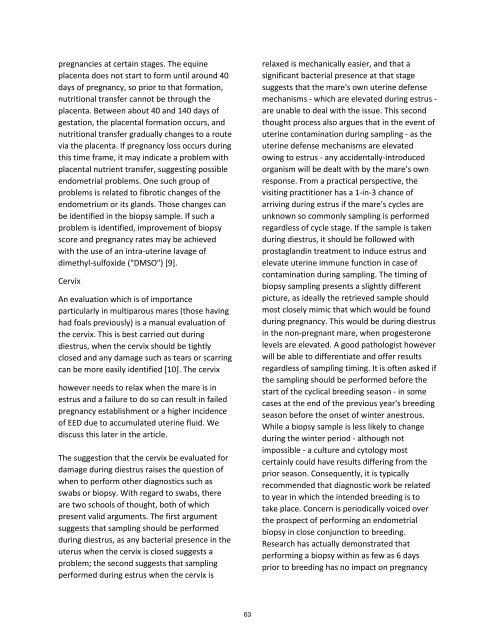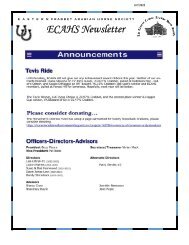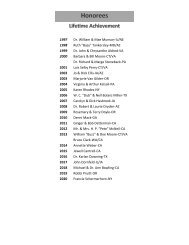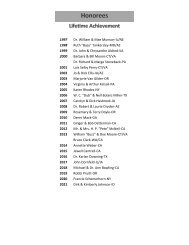Arabian Sport Horse Alliance 2017-2018 Directory & Yearbook
Annual publication of the Arabian Sport Horse Alliance, Inc. Honoree Articles, Award Listings, Photo Galleries, Youth Member Spotlights, Stallion Pages, Farm Profiles, Educational Articles, and more.....
Annual publication of the Arabian Sport Horse Alliance, Inc.
Honoree Articles, Award Listings, Photo Galleries, Youth Member Spotlights, Stallion Pages, Farm Profiles, Educational Articles, and more.....
You also want an ePaper? Increase the reach of your titles
YUMPU automatically turns print PDFs into web optimized ePapers that Google loves.
pregnancies at certain stages. The equine<br />
placenta does not start to form until around 40<br />
days of pregnancy, so prior to that formation,<br />
nutritional transfer cannot be through the<br />
placenta. Between about 40 and 140 days of<br />
gestation, the placental formation occurs, and<br />
nutritional transfer gradually changes to a route<br />
via the placenta. If pregnancy loss occurs during<br />
this time frame, it may indicate a problem with<br />
placental nutrient transfer, suggesting possible<br />
endometrial problems. One such group of<br />
problems is related to fibrotic changes of the<br />
endometrium or its glands. Those changes can<br />
be identified in the biopsy sample. If such a<br />
problem is identified, improvement of biopsy<br />
score and pregnancy rates may be achieved<br />
with the use of an intra-uterine lavage of<br />
dimethyl-sulfoxide ("DMSO") [9].<br />
Cervix<br />
An evaluation which is of importance<br />
particularly in multiparous mares (those having<br />
had foals previously) is a manual evaluation of<br />
the cervix. This is best carried out during<br />
diestrus, when the cervix should be tightly<br />
closed and any damage such as tears or scarring<br />
can be more easily identified [10]. The cervix<br />
however needs to relax when the mare is in<br />
estrus and a failure to do so can result in failed<br />
pregnancy establishment or a higher incidence<br />
of EED due to accumulated uterine fluid. We<br />
discuss this later in the article.<br />
The suggestion that the cervix be evaluated for<br />
damage during diestrus raises the question of<br />
when to perform other diagnostics such as<br />
swabs or biopsy. With regard to swabs, there<br />
are two schools of thought, both of which<br />
present valid arguments. The first argument<br />
suggests that sampling should be performed<br />
during diestrus, as any bacterial presence in the<br />
uterus when the cervix is closed suggests a<br />
problem; the second suggests that sampling<br />
performed during estrus when the cervix is<br />
relaxed is mechanically easier, and that a<br />
significant bacterial presence at that stage<br />
suggests that the mare's own uterine defense<br />
mechanisms - which are elevated during estrus -<br />
are unable to deal with the issue. This second<br />
thought process also argues that in the event of<br />
uterine contamination during sampling - as the<br />
uterine defense mechanisms are elevated<br />
owing to estrus - any accidentally-introduced<br />
organism will be dealt with by the mare’s own<br />
response. From a practical perspective, the<br />
visiting practitioner has a 1-in-3 chance of<br />
arriving during estrus if the mare's cycles are<br />
unknown so commonly sampling is performed<br />
regardless of cycle stage. If the sample is taken<br />
during diestrus, it should be followed with<br />
prostaglandin treatment to induce estrus and<br />
elevate uterine immune function in case of<br />
contamination during sampling. The timing of<br />
biopsy sampling presents a slightly different<br />
picture, as ideally the retrieved sample should<br />
most closely mimic that which would be found<br />
during pregnancy. This would be during diestrus<br />
in the non-pregnant mare, when progesterone<br />
levels are elevated. A good pathologist however<br />
will be able to differentiate and offer results<br />
regardless of sampling timing. It is often asked if<br />
the sampling should be performed before the<br />
start of the cyclical breeding season - in some<br />
cases at the end of the previous year's breeding<br />
season before the onset of winter anestrous.<br />
While a biopsy sample is less likely to change<br />
during the winter period - although not<br />
impossible - a culture and cytology most<br />
certainly could have results differing from the<br />
prior season. Consequently, it is typically<br />
recommended that diagnostic work be related<br />
to year in which the intended breeding is to<br />
take place. Concern is periodically voiced over<br />
the prospect of performing an endometrial<br />
biopsy in close conjunction to breeding.<br />
Research has actually demonstrated that<br />
performing a biopsy within as few as 6 days<br />
prior to breeding has no impact on pregnancy<br />
63












